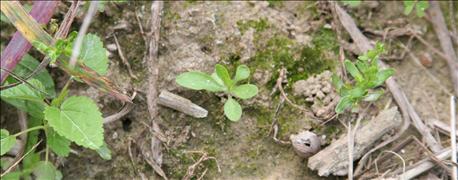
There is a new name in weed control. It’s Elevore, a burndown herbicide from Dow AgroSciences. Jeff Ellis, biology lead for soybean herbicides, says it’s awaiting approval from the U.S. Environmental Protection Agency. The company hopes for a label in the second or third quarter of 2017. So why become aware of it now?
“We believe it will be a real asset for controlling certain tough weeds, especially marestail in the Midwest and South,” he says. Marestail continues to plague growers in key soybean states. There are more options to control it in corn. The spread of glyphosate-resistant marestail has made control tougher.
Elevore also has good activity on chickweed and henbit, Ellis says. That will make it a candidate for use in the fall when those winter annual weeds are problems.
Expect it to be labeled for use ahead of both corn and soybeans, with a 14-day application interval before planting. Recommendations will likely suggest including glyphosate to pick up weeds Elevore doesn’t control. 2,4-D may also be suggested to get specific weeds, Ellis says.
“Residual activity is minimal, and it shouldn’t pose a carryover concern for cover crops,” he adds. Once the product is labeled, refer to the label for exact plant-back restrictions.
New active ingredient
Elevore will bring a new active ingredient to the market for corn and soybeans. However, it doesn’t represent a new mode or site of action. “It’s from a new family of chemistry, but not from a new mode of action,” Ellis says.
Travis Legleiter, Purdue University weed-control specialist, says the active ingredient falls in the synthetic auxin class of growth regulators. A new active ingredient offers another tool for weed control, but it doesn’t offer a new site of action. What would help prevent further development of resistant weeds are new sites of action, the specialist says.
Mode vs. site of action
Understanding the terms mode of action and site of action are crucial, Legleiter says. Weed resistance has forced this extra degree of sophistication in understanding how herbicides work. “Mode of action is how that family of herbicides works, such as being growth regulators and disrupting growth mechanisms within plants,” he says.
Site of action refers to the specific target within a plant or the specific biologic pathway it disrupts. There can be multiple sites of action within one mode of action, he says.
“The classification system we use includes both mode of action and site of action,” he explains. “Group numbers people talk about refer to sites of action. Since Elevore is an auxin, it would be a 4.”
There are already other herbicides classified as 4s on the market, Legleiter says. The object is to use different sites of action on the same field to slow down further resistance.
“We haven’t had a new site of action since the ’90s,” he says. “We’ve had new active ingredients, but not new sites of action. Companies look for them, but it takes a long time and huge investment to develop.”
Glyphosate partner
Partnering Elevore with glyphosate makes sense, Legleiter says. When the product gets a label, Purdue recommendations will advise using glyphosate as well. Glyphosate needs to be in the tank to control other weeds that it still works on,” he says.
About the Author(s)
You May Also Like




